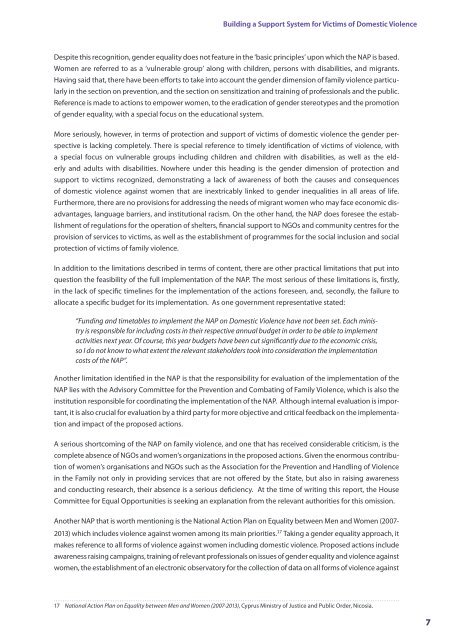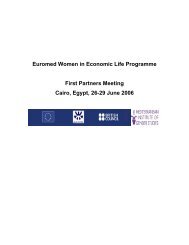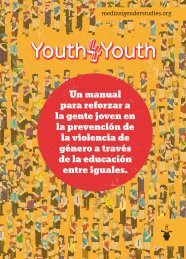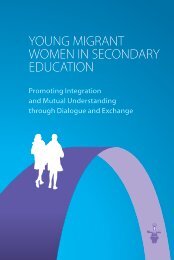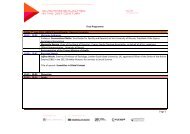react to domestic violence
react to domestic violence
react to domestic violence
Create successful ePaper yourself
Turn your PDF publications into a flip-book with our unique Google optimized e-Paper software.
Building a Support System for Victims of Domestic Violence<br />
Despite this recognition, gender equality does not feature in the ‘basic principles’ upon which the NAP is based.<br />
Women are referred <strong>to</strong> as a ‘vulnerable group’ along with children, persons with disabilities, and migrants.<br />
Having said that, there have been efforts <strong>to</strong> take in<strong>to</strong> account the gender dimension of family <strong>violence</strong> particularly<br />
in the section on prevention, and the section on sensitization and training of professionals and the public.<br />
Reference is made <strong>to</strong> actions <strong>to</strong> empower women, <strong>to</strong> the eradication of gender stereotypes and the promotion<br />
of gender equality, with a special focus on the educational system.<br />
More seriously, however, in terms of protection and support of victims of <strong>domestic</strong> <strong>violence</strong> the gender perspective<br />
is lacking completely. There is special reference <strong>to</strong> timely identification of victims of <strong>violence</strong>, with<br />
a special focus on vulnerable groups including children and children with disabilities, as well as the elderly<br />
and adults with disabilities. Nowhere under this heading is the gender dimension of protection and<br />
support <strong>to</strong> victims recognized, demonstrating a lack of awareness of both the causes and consequences<br />
of <strong>domestic</strong> <strong>violence</strong> against women that are inextricably linked <strong>to</strong> gender inequalities in all areas of life.<br />
Furthermore, there are no provisions for addressing the needs of migrant women who may face economic disadvantages,<br />
language barriers, and institutional racism. On the other hand, the NAP does foresee the establishment<br />
of regulations for the operation of shelters, financial support <strong>to</strong> NGOs and community centres for the<br />
provision of services <strong>to</strong> victims, as well as the establishment of programmes for the social inclusion and social<br />
protection of victims of family <strong>violence</strong>.<br />
In addition <strong>to</strong> the limitations described in terms of content, there are other practical limitations that put in<strong>to</strong><br />
question the feasibility of the full implementation of the NAP. The most serious of these limitations is, firstly,<br />
in the lack of specific timelines for the implementation of the actions foreseen, and, secondly, the failure <strong>to</strong><br />
allocate a specific budget for its implementation. As one government representative stated:<br />
“Funding and timetables <strong>to</strong> implement the NAP on Domestic Violence have not been set. Each ministry<br />
is responsible for including costs in their respective annual budget in order <strong>to</strong> be able <strong>to</strong> implement<br />
activities next year. Of course, this year budgets have been cut significantly due <strong>to</strong> the economic crisis,<br />
so I do not know <strong>to</strong> what extent the relevant stakeholders <strong>to</strong>ok in<strong>to</strong> consideration the implementation<br />
costs of the NAP”.<br />
Another limitation identified in the NAP is that the responsibility for evaluation of the implementation of the<br />
NAP lies with the Advisory Committee for the Prevention and Combating of Family Violence, which is also the<br />
institution responsible for coordinating the implementation of the NAP. Although internal evaluation is important,<br />
it is also crucial for evaluation by a third party for more objective and critical feedback on the implementation<br />
and impact of the proposed actions.<br />
A serious shortcoming of the NAP on family <strong>violence</strong>, and one that has received considerable criticism, is the<br />
complete absence of NGOs and women’s organizations in the proposed actions. Given the enormous contribution<br />
of women’s organisations and NGOs such as the Association for the Prevention and Handling of Violence<br />
in the Family not only in providing services that are not offered by the State, but also in raising awareness<br />
and conducting research, their absence is a serious deficiency. At the time of writing this report, the House<br />
Committee for Equal Opportunities is seeking an explanation from the relevant authorities for this omission.<br />
Another NAP that is worth mentioning is the National Action Plan on Equality between Men and Women (2007-<br />
2013) which includes <strong>violence</strong> against women among its main priorities. 17 Taking a gender equality approach, it<br />
makes reference <strong>to</strong> all forms of <strong>violence</strong> against women including <strong>domestic</strong> <strong>violence</strong>. Proposed actions include<br />
awareness raising campaigns, training of relevant professionals on issues of gender equality and <strong>violence</strong> against<br />
women, the establishment of an electronic observa<strong>to</strong>ry for the collection of data on all forms of <strong>violence</strong> against<br />
17 National Action Plan on Equality between Men and Women (2007-2013), Cyprus Ministry of Justice and Public Order, Nicosia.<br />
7


